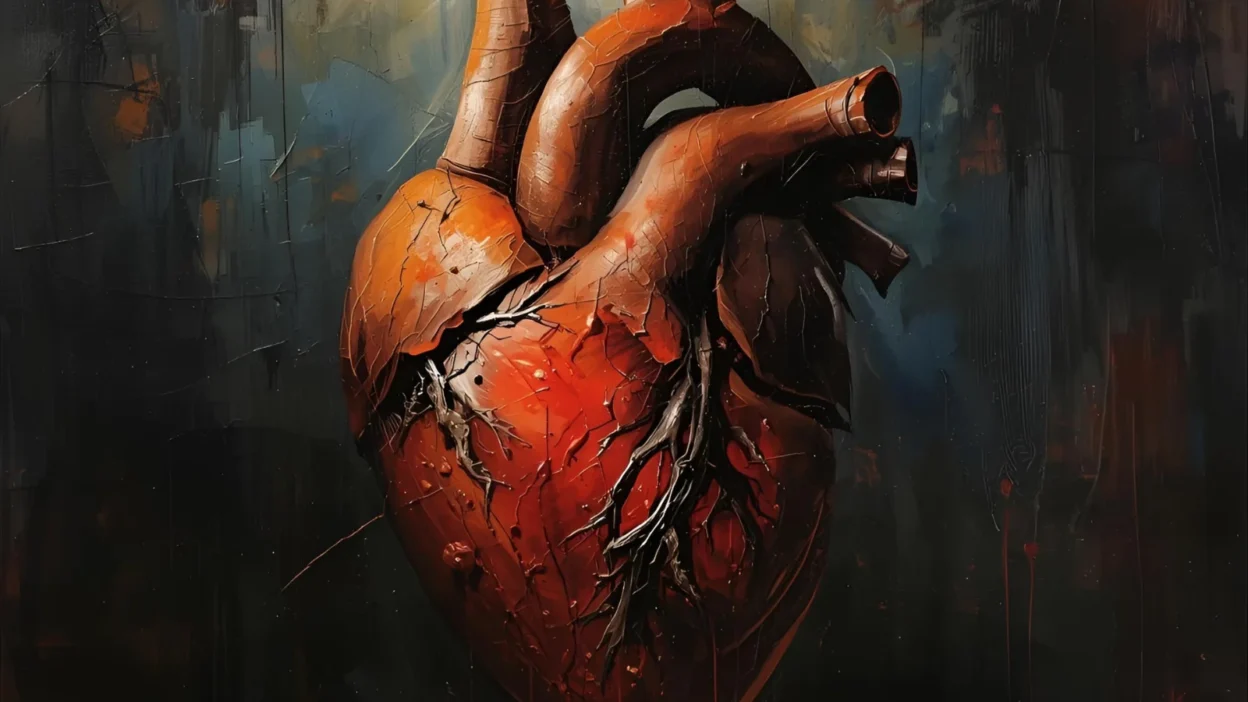Imagine sitting in a silent room at midnight, the only sound being the loud beat of your own heart. Now picture a story where that heartbeat isn’t just your own—it belongs to guilt, fear, and madness. That’s the world Edgar Allan Poe pulls us into with The Tell-Tale Heart.
For decades, readers have felt the chill of this gothic tale, not just because of the suspense, but because of the symbolism in The Tell-Tale Heart that speaks to our deepest human emotions.
People don’t search for Poe’s story only to understand the plot—they search to uncover the hidden symbols, the irony, the foreshadowing, and the eerie imagery that make it unforgettable. Whether it’s the all-seeing eye, the mysterious lantern, or the relentless heartbeat, every detail hides a meaning. In this article, we’ll peel back those layers to uncover what Poe really wanted us to feel.
If you’ve ever wondered why the story feels so disturbingly close to your own human fears—or why students, scholars, and literature lovers keep dissecting it—this guide will help you find the deeper meaning. Let’s step inside the narrator’s world, where guilt takes on sound, sight, and life itself.
Lantern Symbolism in The Tell-Tale Heart
- The lantern represents partial truth—revealing only what the narrator wants to see.
- It shines a narrow light, symbolizing distorted perception rather than clarity.
- The lantern is a tool of obsession, used to watch the old man’s vulture eye.
- Its faint light mirrors the narrator’s weak grip on sanity.
- By hiding and controlling the light, the narrator tries to control reality.
- The lantern serves as a metaphor for selective vision—choosing what to accept and what to ignore.
- It highlights Poe’s theme of madness disguised as rationality.
- Just as light can reveal or conceal, the narrator’s mind flickers between truth and delusion.
- The lantern connects to the gothic theme of darkness versus illumination.
- In essence, the lantern isn’t just an object—it’s the narrator’s broken lens of truth.
The Tell-Tale Heart Symbolism Essay
- A literary essay on this story usually emphasizes madness and guilt.
- The eye stands as the most discussed symbol, tied to paranoia.
- The heartbeat embodies guilt and the inability to escape conscience.
- The darkness in the story shows ignorance and moral blindness.
- The lantern is a smaller but powerful image of control and delusion.
- Essays often argue that the story reflects inner psychological horror more than physical events.
- Symbolism here creates a sense of claustrophobia and dread.
- Poe uses common objects to reflect deep, unsettling truths.
- A strong essay links symbols to universal human fears—like being watched or trapped by guilt.
- Ultimately, symbolism transforms the story into a psychological allegory.
Irony in The Tell-Tale Heart
- The narrator insists he’s sane, which is deeply ironic.
- His calm explanations only prove his madness.
- He kills to escape the eye, but it’s the heartbeat that betrays him.
- He hides the body perfectly, yet his own guilt reveals the crime.
- The more he proclaims intelligence, the more foolish he appears.
- Dramatic irony builds suspense—the reader knows he’s mad before he does.
- Situational irony: seeking peace, he finds eternal torment.
- His obsession with the eye blinds him to his own downfall.
- Verbal irony: “nervous, very dreadfully nervous” opens with false calm.
- Poe uses irony to mirror the contradictions within human psychology.
What Does the Eye in The Tell-Tale Heart Symbolize?
- The eye symbolizes surveillance and judgment.
- It reflects the narrator’s fear of being seen for who he truly is.
- A “vulture eye” connects to death and decay.
- The eye may represent divine justice—always watching.
- It embodies the narrator’s paranoia.
- The eye could also symbolize truth the narrator cannot escape.
- It transforms into a trigger for madness.
- Some interpret it as a symbol of inner conscience projected outward.
- The fixation shows how obsession distorts reality.
- The eye is not just physical—it’s a metaphor for unavoidable truth.
Imagery in The Tell-Tale Heart
- Poe’s imagery uses sound—the heartbeat echoes guilt.
- The darkness sets a mood of fear and suspense.
- Vivid descriptions of the eye create disgust and horror.
- Silence before the heartbeat grows builds tension.
- The imagery of light flickering from the lantern heightens mystery.
- Heartbeat imagery transforms conscience into something tangible.
- “A low, dull, quick sound” makes guilt feel alive.
- The setting imagery reflects the narrator’s mental claustrophobia.
- Repetition in imagery mimics obsessive thought.
- Poe’s images blur lines between inner mind and outer world.
What Does the Eye and the Heart Symbolize in The Tell-Tale Heart?
- The eye = external judgment.
- The heart = inner guilt.
- Together, they symbolize the conflict between external pressure and internal conscience.
- The eye is cold and watchful; the heart is warm and relentless.
- They reflect duality—sight versus sound, outside versus inside.
- The eye triggers violence; the heart delivers justice.
- The eye is fear of being seen; the heart is truth that cannot be silenced.
- Symbolically, both merge into one: inescapable truth.
- The narrator destroys the eye but cannot kill the heartbeat of guilt.
- These two symbols carry the core meaning of Poe’s story.
Literary Devices in The Tell-Tale Heart
- Symbolism – Eye, lantern, heart.
- Irony – Protests of sanity.
- Foreshadowing – Early signs of madness.
- Imagery – Sounds and sights of obsession.
- Repetition – “Louder! Louder!” builds madness.
- Alliteration – Creates rhythm in fear.
- Personification – Guilt given a beating heart.
- Suspense – Pacing increases tension.
- Metaphor – Eye as conscience.
- Tone – Nervous, obsessive, and frantic.
Foreshadowing in The Tell-Tale Heart
- The narrator admits nervousness—clue to madness.
- His obsession with the eye foreshadows murder.
- The slow nightly visits predict the final crime.
- Mention of hearing things in heaven and hell hints delusion.
- The heartbeat mentioned early signals its final dominance.
- His insistence on sanity foreshadows collapse.
- Repetition of “stealth” hints he won’t succeed.
- Calm tone foreshadows sudden outburst.
- Eye as a vulture hints at death.
- Each detail sets up the inevitable confession.
The Tell-Tale Heart PDF
- Readers often search for the full text PDF of The Tell-Tale Heart.
- The PDF preserves Poe’s chilling language and rhythm.
- Teachers use it for symbolism analysis essays.
- Students download PDFs for quick reference in literary studies.
- The PDF is short but packed with literary devices.
- Having the PDF helps highlight recurring themes.
- Scholars annotate it for symbolism and foreshadowing.
- The PDF remains one of Poe’s most accessed works online.
- It’s valuable for classroom, study, or personal reflection.
- Always ensure you download it from a reliable source.
Symbolism in The Tell-Tale Heart Summary
- The story uses the eye and heartbeat as primary symbols.
- The lantern shows selective perception.
- Darkness and light mirror ignorance versus awareness.
- Irony and imagery strengthen symbolic meaning.
- The narrator’s mind becomes a symbol of madness itself.
- Themes of guilt, paranoia, and truth run throughout.
- Death is not just physical but psychological.
- Poe’s gothic style makes symbols terrifyingly real.
- Summary: symbols = keys to understanding deeper meaning.
- Without symbolism, the story loses its emotional power.
Symbolism in The Tell-Tale Heart PDF
- Many readers want an academic PDF on symbolism.
- PDFs help students analyze the eye, heart, and lantern.
- They often include breakdowns of imagery and irony.
- Teachers prepare lesson plans in PDF form.
- Scholars use symbolism PDFs for research papers.
- They provide detailed quotes and analysis.
- Having a PDF saves time for students writing essays.
- PDFs are downloadable study tools for Poe enthusiasts.
- They preserve consistent formatting for teaching.
- Symbolism PDFs keep Poe’s work accessible and relevant.
Symbolism in The Tell-Tale Heart PPT
- A PPT is a common tool for teaching symbolism.
- Slides often cover eye, lantern, and heartbeat.
- Teachers add quotes with explanations.
- Visuals show how symbols connect to themes.
- PPTs help simplify Poe’s complex meanings.
- They often include student discussion questions.
- Great for group projects on literary analysis.
- PPTs make Poe’s gothic story more approachable.
- They highlight key symbolism and irony.
- A well-made PPT ensures students grasp the depth of meaning.
Real-Life 3 Short Scenarios
- A college student analyzing the eye realizes it mirrors her own fear of being judged by peers.
- A teacher uses the heartbeat symbol to explain guilt in her classroom, helping students relate it to real-life honesty.
- A literature fan reads the story at night, and the lantern imagery reminds him of how fear hides in shadows.
FAQs
1. Why is symbolism important in The Tell-Tale Heart?
Because it transforms ordinary objects into reflections of guilt, madness, and truth.
2. What does the heartbeat symbolize?
It symbolizes guilt that cannot be silenced.
3. Is the narrator sane?
No—his repeated insistence on sanity is actually evidence of madness.
4. Why does Poe use an “eye” as a symbol?
The eye represents constant surveillance, truth, and inner paranoia.
5. Can this story be read as a psychological allegory?
Yes—it reflects the battle between conscience and obsession.
Conclusion with Emotional Closure
Edgar Allan Poe’s The Tell-Tale Heart is more than a gothic horror tale—it’s a mirror into our fears, guilt, and inner truths. Through symbolism the eye, the lantern, the heartbeat Poe shows us that no matter how hard we hide from guilt, it will always find a way to be heard.
For readers searching for deeper meaning, this story reminds us that our own hearts can be the loudest truth-tellers of all.
So next time you feel your heart racing with guilt or fear, remember Poe’s timeless message: truth cannot be silenced.




